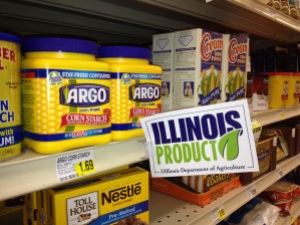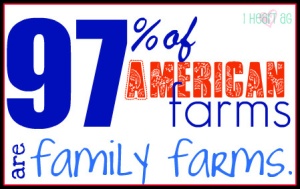As Americans, we are blessed with many choices and opportunities, as well as the freedom to choose what we want. Food, for instance. We’ve got conventional, organic, local, generic brand, name brand, Walmart, Kroger’s, the local farmers market, low-fat, diet, dairy, non-dairy, soy, homemade and to-go….the list goes on and on. While it’s great that we have that opportunity and freedom to select what we want, our choices normally fit the categories of “it tastes good”, “it’s cheap”, “it’s nutritious”, and “I’ve only got 20 minutes for lunch”.
Something new that consumers (you) are beginning to factor in is the environment. The Local Foods movement argues that transporting food across the country racks up something called food miles. Basically this factors in the cost per mile for the fuel to get the food from point A to the grocery, as well as the environmental cost inflicted because of the carbon dioxide emitted from the transport vehicle. While it’s great to support your local farmers, it’s not ideal for sustaining agriculture (see my past post, Keeping it Local, for more on why it just isn’t going to work).
Another movement that claims to be environmentally conscious is organic agriculture. Organic seems to give the impression that the food was produced without using GMO (genetically modified….we’ll dive into that one some other time) seeds, natural fertilizers, pesticide-free, antibiotic-free and whatever else has been claimed most recently. Here’s the fact: it is not any of those things. Getting down to it, USDA organic certification basically only verifies that the crop (or animal) was raised using certain types of pesticides and fertilizers, and that the livestock were fed using organically produced feed.
Fertilizers are used to replace nutrients in the soil that were used up by the previous crop. Our ancestors understood that manure somehow helped their plants grow better than without the manure, we’ve just fine-tuned it since then.
Pesticides were created to cut down on the required labor to care for the crop. As the workforce moved to the cities to work in factories way back in the day, farmers were faced with a lack of available labor. Eventually pesticides were created. These pesticides are not one cure-all for crop “illnesses”, rather they target a specific issue. For example, we’ve all heard of Round-up. Round-up kills weeds. Other pesticides target different diseases and insects. There are just some things that cannot be solved with manpower, and this makes it possible for farmers to produce enough food to feed not only our country, but a considerable percentage of the world population.
Farmers are the stewards of our environment. Why should we differentiate between “organic” and “conventional” products (conventional means that the farmer used agricultural technologies, such as pesticides)? All of these new practices have been implemented for a reason. Farmers are trying to improve yield quality and quantity while taking care of their land. Their land is their livelihood. Why would they want to intentionally harm it? The important thing to keep in mind is that, like you, a farmer is a real person working to provide for their family.
Keep in mind that local or organic foods are not going to feed our next generation, but know that those choices will always be on the grocery store shelves. I’m not saying that the local or organic products are bad for you. In fact, they’ve created great niche markets for themselves. I’m saying that you, the consumer, should challenge the claims made by these markets. Ask yourself why you are buying that product. If you choose it because it has fewer of those food miles or you feel that it is healthier for your family, by all means buy the product. I’m not here to make your choices- YOU are an American. We are internationally known for our freedom, so use it next time you’re at the supermarket and you find that you have 15 different choices of ketchup/catsup/whatever you like to dip your fries in. Choose what is best for YOU.



8 Comments
A Farm Kid's Guide to Agriculture | Thank a Farmer
August 1, 2013 at 6:31 pm[…] It’s up to the consumer to choose what is best for themselves. (See my previous post on this, Choices.) Where Panera went wrong was to discredit other farming practices through EZChicken in the hopes […]
A Farm Kid's Guide to Agriculture | Thank a Farmer
August 1, 2013 at 6:31 pm[…] It’s up to the consumer to choose what is best for themselves. (See my previous post on this, Choices.) Where Panera went wrong was to discredit other farming practices through EZChicken in the hopes […]
A Farm Kid's Guide to Agriculture | My Beef with Chipotle
February 27, 2014 at 2:24 pm[…] consume and Chipotle’s choice to choose what foods they want to serve. (See my previous post, Choices, for more). But the way that Chipotle is advertising this is what has gotten me and many members of […]
A Farm Kid's Guide to Agriculture | My Beef with Chipotle
February 27, 2014 at 2:24 pm[…] consume and Chipotle’s choice to choose what foods they want to serve. (See my previous post, Choices, for more). But the way that Chipotle is advertising this is what has gotten me and many members of […]
My Beef with Chipotle | A Farm Kid's Guide to Agriculture
September 26, 2014 at 3:49 pm[…] consume and Chipotle’s choice to choose what foods they want to serve. (See my previous post, Choices, for more). But the way that Chipotle is advertising this is what has gotten me and many members of […]
My Beef with Chipotle | A Farm Kid's Guide to Agriculture
September 26, 2014 at 3:49 pm[…] consume and Chipotle’s choice to choose what foods they want to serve. (See my previous post, Choices, for more). But the way that Chipotle is advertising this is what has gotten me and many members of […]
Thank a Farmer | A Farm Kid's Guide to Agriculture
September 26, 2014 at 3:55 pm[…] It’s up to the consumer to choose what is best for themselves. (See my previous post on this, Choices.) Where Panera went wrong was to discredit other farming practices through EZChicken in the hopes […]
Thank a Farmer | A Farm Kid's Guide to Agriculture
September 26, 2014 at 3:55 pm[…] It’s up to the consumer to choose what is best for themselves. (See my previous post on this, Choices.) Where Panera went wrong was to discredit other farming practices through EZChicken in the hopes […]